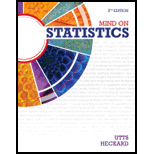
Concept explainers
Exercises 5.110 to 5.112 refer to a survey of University of California faculty members on affirmative action policies for the university (Roper Center, 1996). The survey was based on telephone interviews with a random sample of 1001 faculty members conducted In December 1995.
One question asked was as follows: The term affirmative action has different meanings to different people. Please tell me which statement best describes what you mean by the term: First, affirmative action means granting preferences to women and certain racial and ethnic groups. Second, affirmative action means promoting equal opport unities for all individuals without regard to their race, sex, or ethnicity.” The options “Neither or Both” were not given and were recorded only if the respondent offered them. The first statement was chosen by 37%, the second one by 43%, Neither” by 13%, and “Both” by 2%. The remainder said, ‘Don’t know.” The organization that comm issioned the poll, the California Association of Scholars, issued a press release that said in reference to this quest ion, These findings demolish the claim that the faculty at UC wants preferential policies.” Refer to the Possible Sources of Response Bias in Surveys” in Section 5.6, and discuss them in the context of this question and resulting press release.
Want to see the full answer?
Check out a sample textbook solution
Chapter 5 Solutions
Mind on Statistics
- A company found that the daily sales revenue of its flagship product follows a normal distribution with a mean of $4500 and a standard deviation of $450. The company defines a "high-sales day" that is, any day with sales exceeding $4800. please provide a step by step on how to get the answers in excel Q: What percentage of days can the company expect to have "high-sales days" or sales greater than $4800? Q: What is the sales revenue threshold for the bottom 10% of days? (please note that 10% refers to the probability/area under bell curve towards the lower tail of bell curve) Provide answers in the yellow cellsarrow_forwardFind the critical value for a left-tailed test using the F distribution with a 0.025, degrees of freedom in the numerator=12, and degrees of freedom in the denominator = 50. A portion of the table of critical values of the F-distribution is provided. Click the icon to view the partial table of critical values of the F-distribution. What is the critical value? (Round to two decimal places as needed.)arrow_forwardA retail store manager claims that the average daily sales of the store are $1,500. You aim to test whether the actual average daily sales differ significantly from this claimed value. You can provide your answer by inserting a text box and the answer must include: Null hypothesis, Alternative hypothesis, Show answer (output table/summary table), and Conclusion based on the P value. Showing the calculation is a must. If calculation is missing,so please provide a step by step on the answers Numerical answers in the yellow cellsarrow_forward
 Big Ideas Math A Bridge To Success Algebra 1: Stu...AlgebraISBN:9781680331141Author:HOUGHTON MIFFLIN HARCOURTPublisher:Houghton Mifflin Harcourt
Big Ideas Math A Bridge To Success Algebra 1: Stu...AlgebraISBN:9781680331141Author:HOUGHTON MIFFLIN HARCOURTPublisher:Houghton Mifflin Harcourt Holt Mcdougal Larson Pre-algebra: Student Edition...AlgebraISBN:9780547587776Author:HOLT MCDOUGALPublisher:HOLT MCDOUGAL
Holt Mcdougal Larson Pre-algebra: Student Edition...AlgebraISBN:9780547587776Author:HOLT MCDOUGALPublisher:HOLT MCDOUGAL Glencoe Algebra 1, Student Edition, 9780079039897...AlgebraISBN:9780079039897Author:CarterPublisher:McGraw Hill
Glencoe Algebra 1, Student Edition, 9780079039897...AlgebraISBN:9780079039897Author:CarterPublisher:McGraw Hill


